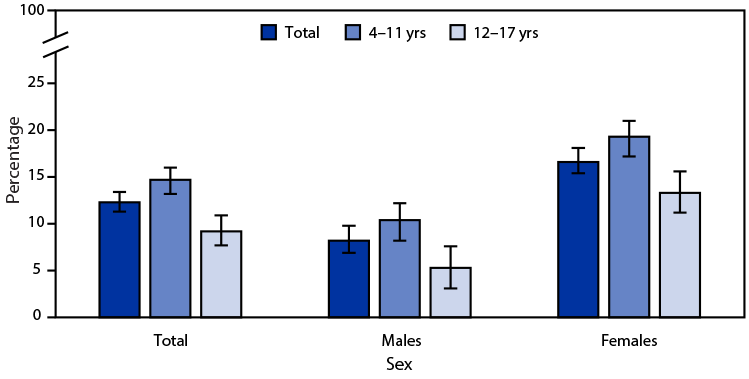QuickStats: Percentage* of Children and Adolescents Aged 4–17 Years Who Practiced Yoga During the Past 12 Months,† by Sex and Age Group — National Health Interview Survey,§ United States, 2022
Weekly / November 17, 2023 / 72(46);1279
Altmetric:

* With 95% CIs indicated by error bars.
† Based on an affirmative response to the survey question, “During the past 12 months, did (child) ever practice yoga as part of a class or on their own?”
§ Estimates are based on household interviews of a sample of the civilian, noninstitutionalized U.S. population.
In 2022, 12.3% of children and adolescents aged 4–17 years had practiced yoga in the past 12 months. Children and adolescents aged 4–11 years were more likely to have practiced yoga than those aged 12–17 years (14.7% versus 9.2%). The declining percentages with age were found for both males and females: 10.4% versus 5.3% among males, and 19.3% versus 13.3% among females. Males were less likely than females to have practiced yoga in both age groups.
Source: National Center for Health Statistics, National Health Interview Survey, 2022. https://www.cdc.gov/nchs/nhis.htm
Reported by: Cynthia Reuben, MA, creuben@cdc.gov.
For more information on this topic, CDC recommends the following link: https://www.cdc.gov/healthyschools/bam/cards/yoga.html
Suggested citation for this article: QuickStats: Percentage of Children and Adolescents Aged 4–17 Years Who Practiced Yoga During the Past 12 Months, by Sex and Age Group — National Health Interview Survey, United States, 2022. MMWR Morb Mortal Wkly Rep 2023;72:1279. DOI: http://dx.doi.org/10.15585/mmwr.mm7246a6.
MMWR and Morbidity and Mortality Weekly Report are service marks of the U.S. Department of Health and Human Services.
Use of trade names and commercial sources is for identification only and does not imply endorsement by the U.S. Department of
Health and Human Services.
References to non-CDC sites on the Internet are
provided as a service to MMWR readers and do not constitute or imply
endorsement of these organizations or their programs by CDC or the U.S.
Department of Health and Human Services. CDC is not responsible for the content
of pages found at these sites. URL addresses listed in MMWR were current as of
the date of publication.
All HTML versions of MMWR articles are generated from final proofs through an automated process. This conversion might result in character translation or format errors in the HTML version. Users are referred to the electronic PDF version (https://www.cdc.gov/mmwr) and/or the original MMWR paper copy for printable versions of official text, figures, and tables.
Questions or messages regarding errors in formatting should be addressed to mmwrq@cdc.gov.